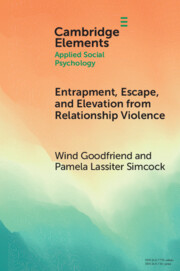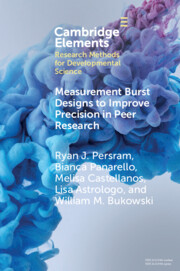Refine search
Actions for selected content:
53 results
Chapter 57 - Centre for Appearance Research Valence (CARVAL) and Salience (CARSAL) Scales
-
-
- Book:
- Handbook of Body Image-Related Measures
- Published online:
- 21 November 2025
- Print publication:
- 20 November 2025, pp 176-178
-
- Chapter
- Export citation
Factors affecting the confidence of surgical trainees: a systematic review and thematic analysis
-
- Journal:
- The Journal of Laryngology & Otology / Volume 139 / Issue 11 / November 2025
- Published online by Cambridge University Press:
- 16 July 2025, pp. 1007-1014
- Print publication:
- November 2025
-
- Article
- Export citation
Reconstructing the Self: Assessing Self-Esteem and Criminal Social Identity in Violent Offenders for Rehabilitation in the Indian Penal System
-
- Journal:
- International Annals of Criminology / Volume 63 / Issue 1 / March 2025
- Published online by Cambridge University Press:
- 18 July 2025, pp. 134-164
- Print publication:
- March 2025
-
- Article
-
- You have access
- Open access
- HTML
- Export citation
The Dark Side of the Self: When Family is Highly Related to Mental Health Deterioration
-
- Journal:
- The Spanish Journal of Psychology / Volume 28 / 2025
- Published online by Cambridge University Press:
- 25 February 2025, e4
-
- Article
-
- You have access
- Open access
- HTML
- Export citation
‘The Work That Reconnects’: a groupwork methodology for enhancing adaptive responses to the climate and ecological crisis
- Part of
-
- Journal:
- The Cognitive Behaviour Therapist / Volume 17 / 2024
- Published online by Cambridge University Press:
- 30 October 2024, e30
-
- Article
- Export citation
Recurrent depression and relational trauma: a single case of memory processing
-
- Journal:
- The Cognitive Behaviour Therapist / Volume 17 / 2024
- Published online by Cambridge University Press:
- 15 April 2024, e14
-
- Article
-
- You have access
- Open access
- HTML
- Export citation
Neural activity during negative self-evaluation is associated with negative self-concept and depressive symptoms in adolescent girls
-
- Journal:
- Development and Psychopathology / Volume 37 / Issue 1 / February 2025
- Published online by Cambridge University Press:
- 13 December 2023, pp. 125-135
-
- Article
-
- You have access
- Open access
- HTML
- Export citation
14 - Social-Cognitive Development and Early Prosocial Behavior
- from Part II - Antecedents and Mechanisms of Prosociality
-
-
- Book:
- The Cambridge Handbook of Prosociality
- Published online:
- 25 May 2023
- Print publication:
- 08 June 2023, pp 275-299
-
- Chapter
- Export citation
Associations between participation and personal factors in community-dwelling adults post-stroke
-
- Journal:
- Brain Impairment / Volume 24 / Issue 3 / December 2023
- Published online by Cambridge University Press:
- 20 December 2022, pp. 456-473
-
- Article
-
- You have access
- Open access
- HTML
- Export citation

Entrapment, Escape, and Elevation from Relationship Violence
-
- Published online:
- 03 June 2022
- Print publication:
- 23 June 2022
-
- Element
- Export citation
Childhood adversity and recurrence of psychotic experiences during adolescence: the role of mediation in an analysis of a population-based longitudinal cohort study
-
- Journal:
- Psychological Medicine / Volume 53 / Issue 9 / July 2023
- Published online by Cambridge University Press:
- 21 March 2022, pp. 4046-4054
-
- Article
-
- You have access
- Open access
- HTML
- Export citation

Measurement Burst Designs to Improve Precision in Peer Research
-
- Published online:
- 20 September 2021
- Print publication:
- 14 October 2021
-
- Element
- Export citation
Very preterm birth and trajectories of domain-specific self-concept from childhood into adulthood
-
- Journal:
- Development and Psychopathology / Volume 34 / Issue 5 / December 2022
- Published online by Cambridge University Press:
- 20 August 2021, pp. 1926-1937
-
- Article
-
- You have access
- Open access
- HTML
- Export citation
5 - Emotion, Cognition, and Engagement in GLL
-
- Book:
- The Gifted Language Learner
- Published online:
- 10 June 2021
- Print publication:
- 24 June 2021, pp 107-136
-
- Chapter
- Export citation
13 - Selfhood and Self-Construal
- from Section 3 - Cognitive and Social Factors
-
-
- Book:
- The Cambridge Handbook of the International Psychology of Women
- Published online:
- 20 July 2020
- Print publication:
- 06 August 2020, pp 179-189
-
- Chapter
- Export citation
11 - Advances in Self-Expansion
- from Part III - Interdependence, Goal Pursuit, and Person Factors
-
-
- Book:
- Interdependence, Interaction, and Close Relationships
- Published online:
- 19 June 2020
- Print publication:
- 18 June 2020, pp 225-245
-
- Chapter
- Export citation
Self-concept, post-traumatic self-appraisals and post-traumatic psychological adjustment: what are the relationships?
-
- Journal:
- Behavioural and Cognitive Psychotherapy / Volume 48 / Issue 4 / July 2020
- Published online by Cambridge University Press:
- 17 April 2020, pp. 463-480
- Print publication:
- July 2020
-
- Article
- Export citation
Construction and interpretation of self-related function and dysfunction in Intercultural Psychiatry
-
- Journal:
- European Psychiatry / Volume 27 / Issue S2 / June 2012
- Published online by Cambridge University Press:
- 15 April 2020, pp. S32-S43
-
- Article
- Export citation
33 - Schaffner on Levels and Selves
- from Section 11
-
-
- Book:
- Levels of Analysis in Psychopathology
- Published online:
- 02 April 2020
- Print publication:
- 02 April 2020, pp 410-418
-
- Chapter
- Export citation
The self-as-mother in the preschool years: an interpretive phenomenological analysis
-
- Journal:
- Children Australia / Volume 45 / Issue 1 / March 2020
- Published online by Cambridge University Press:
- 26 May 2020, pp. 48-53
- Print publication:
- March 2020
-
- Article
- Export citation
